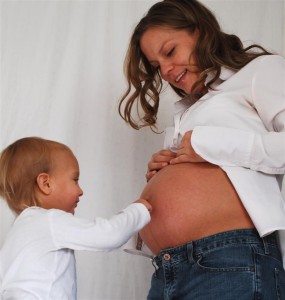 When people talk about baby-led weaning, they are usually referring to the method of introducing solid food that involves introducing finger foods and allowing the baby to decide what and how much to eat, rather than the parents spoon feeding baby food. Over time, feedings at the breast are gradually replaced with self-feeding of the same types of solid foods eaten by the rest of the family.
When people talk about baby-led weaning, they are usually referring to the method of introducing solid food that involves introducing finger foods and allowing the baby to decide what and how much to eat, rather than the parents spoon feeding baby food. Over time, feedings at the breast are gradually replaced with self-feeding of the same types of solid foods eaten by the rest of the family.
But breastfeeding is about more than just food. So in families that have chosen child-led weaning, meaning that the child (not the mother) decides when to stop nursing, the gradual process of weaning involves not only introducing other forms of food, but also other forms of comfort.
In our family, our babies were always nursed to sleep. That meant that I, as the nursing mom, lay down with them at bedtime and nursed them until the gulps turned to flutters and they drifted off to sleep. I could then sneak out and go about the rest of my evening. If I wasn’t there, Daddy would do, but their preference was always to nurse to sleep. We never pushed or forced independent sleep, knowing that like eating, walking, talking, reading and so many other things, they would one day be able to do it on their own. It might require some guidance and some reassurance, but certainly not force.
As it happens, both of our children were ready to give up nursing to sleep before they were ready to give up having a parent present at bedtime. Nursing is a powerful sleep tool and our kids needed something to replace it. Something that would help them go off smiling and secure into the Land of Nod. They didn’t stop nursing at bedtime all at once. It happened gradually. With both of them, they went from nursing to sleep to nursing at bedtime but not falling asleep while nursing.
So then what do you do with a still awake child that has finished nursing?
In our case, in child-led fashion, each of our kids decided for themselves what comfort they needed that would help them doze off. With Julian, it was an involved process. He wanted his back rubbed while being sang to. The Thomas the Tank Engine theme song, the Elmo Song, the Wheels on the Bus, over and over and over again. He wasn’t always quick to fall asleep and I would find myself drifting away mid-song as I tried to get him to sleep. With Emma, who is now just shy of three years old and only nurses at bedtime about every third night or so, the request is clear and simple: “Mommy, cuddle my bum.”
So I cuddle. Because she wants me to, because it comforts her, and because one day she won’t want me to anymore.
Photo credit: ibu menyusui on flickr
Annie blogs about the art and science of parenting at the PhD in Parenting blog. She wrote this post after cuddling her little girl to sleep.


 breastfeeding
breastfeeding Happy New Year!
Happy New Year!
